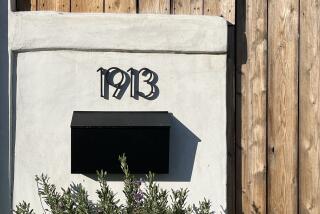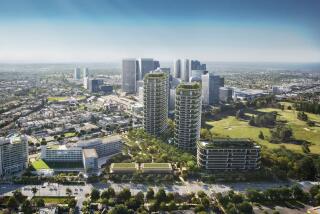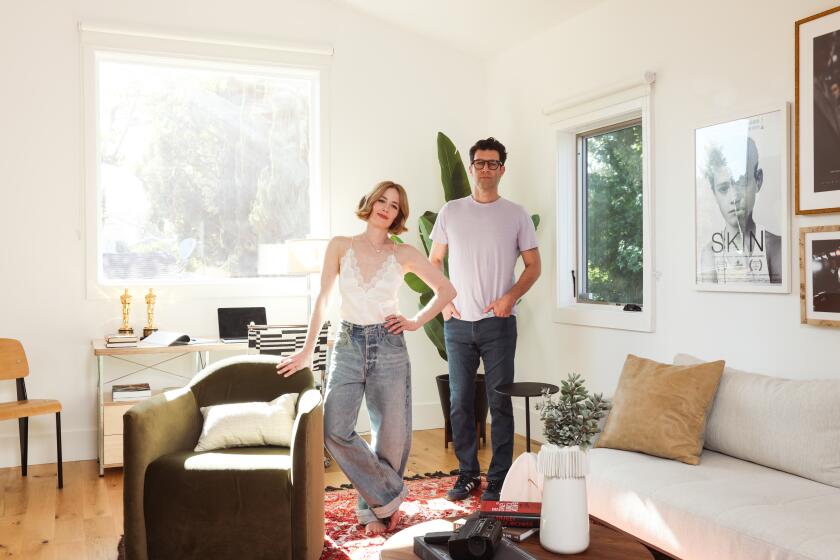BANKING ON THE VALUE OF HISTORY
In a city whose population disdains aging, it’s more than a little ironic that older homes in designated historic districts have become quite the rage.
Twenty-eight years after their inception, Historic Preservation Overlay Zones, or HPOZs, are popping up all around Los Angeles as residents seek to preserve their neighborhoods, prevent the spread of mansionization and protect their home values.
“The success of the early HPOZs has caused an explosion of interest in the last decade,” said Ken Bernstein, manager of the Office of Historic Resources in the city’s planning department. All but eight of L.A.’s 22 zones were established after 2000, and applications from 16 other neighborhoods are pending.
Within these areas -- usually featuring homes of distinctive architectural styles -- owners may not alter exteriors, add on or demolish without having plans reviewed and approved by their local HPOZ board. Exterior changes that fall under scrutiny can include picking paint colors, replacing window frames and adding rooms.
Such oversight rankles some homeowners, who protest that the rules are too restrictive and make home maintenance more expensive. But as sales data bear out, homes within these historic areas sell at a premium over similar houses outside them and values outpace nearby neighborhoods -- a point touted by realty agents and preservation experts.
Of course, being designated a preservation zone is not appropriate for every area, Bernstein said, adding that his office works to ensure it’s used only where appropriate.
“The primary goal of HPOZs is to help preserve and enhance the historic character of a neighborhood,” he said.
One reason buyers value historic districts is this perceived measure of protection for the character of an area, said David Raposa, owner of City Living Realty in Los Angeles and who specializes in historic properties in the West Adams zone, which is known for its Craftsman bungalows. “HPOZs pull more investment money into the blocks they’re on,” he said, “and those blocks will appraise higher.”
Neighborhood benefits
HPOZs particularly benefit lower-income areas, Raposa noted, because buyers who are willing to improve and maintain historic homes raise the value of the neighborhood for all.
“So even if a resident in an HPOZ has no desire to sell their property, if they want to refinance, they’ll benefit as well, because the whole neighborhood’s value is increasing,” he said.
Although a historic zone can be used to preserve character, such as Angelino Heights’ cluster of Victorians, experts disagree over its use to curb new development.
“We’ve seen some communities turn to HPOZs in response to the mansionization issue,” said city official Bernstein, “and HPOZs are not the best tool to address this.” For example, he said, neighborhoods in Granada Hills and Valley Glen had considered applying for historic status to combat mansionization concerns but decided not to after holding community meetings and discussing alternatives.
Bernstein cited a citywide anti-mansionization ordinance that’s been approved by the Planning Commission, and is scheduled to go before the City Council, as a better way to prevent mansionization.
Others, however, see historic zones as effective barriers that should be utilized.
“With the increase in mansionization in Los Angeles, HPOZs are recognized as the most effective tool to deal with that issue right now,” said Mike Buhler, director of advocacy for the Los Angeles Conservancy, a nonprofit preservation group. “The popularity of HPOZs is at its peak. The conservancy receives an inquiry literally every week from a community interested in establishing one.”
Preservationists acknowledge that maintaining historic homes in an HPOZ can be an expensive proposition but say it’s worth it.
Joe Williams, president of Culver City-based Valu Finders Inc., which provides real estate inspections and appraisals, serves on the Lafayette Square HPOZ board. Williams and his wife, Catherine, bought a 1916 Colonial Revival in Lafayette Square in Mid-City L.A. 13 years ago for $335,000. Since then they’ve refinished all the wood in the house, including baseboards and crown moldings; restored two bathrooms with original fixtures; renovated a third bathroom and the kitchen; and restored the porte-cochere.
“Historic renovation requires a level of passion and commitment, which can cost significantly more than just remodeling a home,” Williams said. “But as an appraiser, I know that homes within an HPOZ are more valuable than those outside an HPOZ. . . . Now that the market’s cooled off, people see that our neighborhood’s stable, and appreciation’s grown like the best of the market.”
HPOZs cover about 1.5% of the city’s houses or about 14,000 properties. Although this represents a sliver of the housing share available, realty agents say it is a lucrative segment.
Anne Loveland, a sales associate with Coldwell Banker in Larchmont Village, specializes in historic properties in Windsor Square and Hancock Park, long thought to be among the most prestigious areas of the city.
“Typically, people who are attracted to a neighborhood that’s an HPOZ are attracted to the aesthetics, the setback of front yards, and the architectural continuity and purity,” Loveland said. “There are always people who appreciate the historic homes and will pay a premium for them because there are fewer and fewer available.”
Neither neighborhood’s historic status, however, was granted without opposition.
Windsor Square’s HPOZ status was temporarily repealed in 2006 while the city responded to a Los Angeles Superior Court ruling that it had violated the California Environmental Quality Act by failing to study the impact of establishing the district, which critics said could affect the development of future housing in the area and the installation of energy-efficient technology, such as solar panels, on houses.
Following the court challenge, the city reapproved Windsor Square as an HPOZ with a revised environmental clearance, finding that there are no environmental impacts on the area by making it an HPOZ. Opponents have now filed a new challenge with Superior Court.
In nearby Hancock Park, L.A.’s newest zone, beautifully landscaped lawns, street lights and trees frame elegant, early 20th century mansions. The Hancock Park HPOZ has been operating since last year under interim procedures, without an HPOZ board, with projects being reviewed by city planning department staff. The city’s planning department is re-submitting the Hancock Park HPOZ proposal to the City Council this fall, addressing the environmental review issues raised in the Windsor Square litigation.
“I don’t want to diminish the importance of maintaining the aesthetics of the neighborhood, but I am against government usurping the rights of homeowners,” said Warren Lent, a plastic surgeon and 13-year Hancock Park resident who opposed the designation.
“The HPOZ board also has the potential of being used by one group of neighbors against others in divided communities,” he said. “I may not like what a person chooses to do on their individual lot, but I have to respect their rights as a homeowner.”
Working with the city
Lent is continuing to press his concerns by working with the city in formulating policy for Hancock Park’s HPOZ. He has proposed that the HPOZ board’s review authority be limited to the front facades of houses and that board members be vetted for special community interests before appointment.
Currently, any change affecting 50% or more of a house within the HPOZ has to be reviewed by City Councilman Tom LaBonge’s office and the city’s planning department, according to Susan Grossman, a member of the Hancock Park Homeowners Assn. She and her husband, Kim, have lived in a 1921 English Revival cottage purchased in 1984.
“Before the interim control . . . went into effect, we saw a large house being built just a few blocks away. This part of Hancock Park has small 1,200-square-foot homes. People are paying a million dollars for these tiny houses, and they want more space for their money, but it makes the neighborhood less attractive.”
Supporters such as Jolene Snett, president of the Hancock Park Historic Preservation Advocacy Group, echo her sentiment. “After we moved in seven years ago, we saw houses being bought and torn down, or bastardized badly, and it was like a stab to my heart,” she said. “I feel passionate about preserving the neighborhood for my children and generations to come. It’s an historical neighborhood. It’s not a movie set.”
More to Read
Sign up for Essential California
The most important California stories and recommendations in your inbox every morning.
You may occasionally receive promotional content from the Los Angeles Times.





